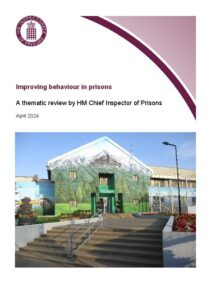Improving behaviour in prisons: A thematic review
Improving behaviour in prisons - report (PDF, 6.4 MB)
In this thematic report, we identify the features of eight prisons which were creating cultures that encouraged men and women to engage constructively with staff and make better use of their time in custody.
Commenting on the report HM Chief Inspector of Prisons, Charlie Taylor, said:
Prisons in England and Wales are almost full, with men and women serving increasingly long sentences often in overcrowded and squalid conditions. Reoffending rates remain high, and levels of assaults and self-harm are rising. Drugs too are an increasing problem in many jails, despite the use of technology designed to prevent their incursion.
Against this backdrop, it is more important than ever that prison leaders find ways to develop cultures that support prisoners to behave well. If we want to see less reoffending and fewer victims of crime, prisons must deliver on their purpose to protect the public by working with prisoners to help them prepare for their return to society. But we know how difficult it is for staff to do their job when they are spending too much of their time managing disruptive behaviour. We often report on prisons where behaviour is unacceptable, rules are not clear or enforced, staff lack confidence and do not feel supported by leaders, sanctions are not followed up and there is no effective system in place to motivate prisoners to behave.
Yet we know that some prisons have bucked this trend, creating cultures that encourage men and women to engage constructively with staff and make better use of their time in custody.
In this thematic report, we identify the features of these prisons in the expectation that others will learn from the example, innovation and insight that they offer. We visited eight jails during our research, as well as holding discussion groups with ex-prisoners, governors and academics.
We hope that our report inspires prison leaders to look for what is achievable within their own establishment. But there is no magic wand that can remove the pressure of rising populations, failing infrastructure and a dearth of experienced staff, and we have been calling for some time now for a serious conversation about who we send to prison, for how long and what we want to happen during their time in custody to reduce future victims of crime.


